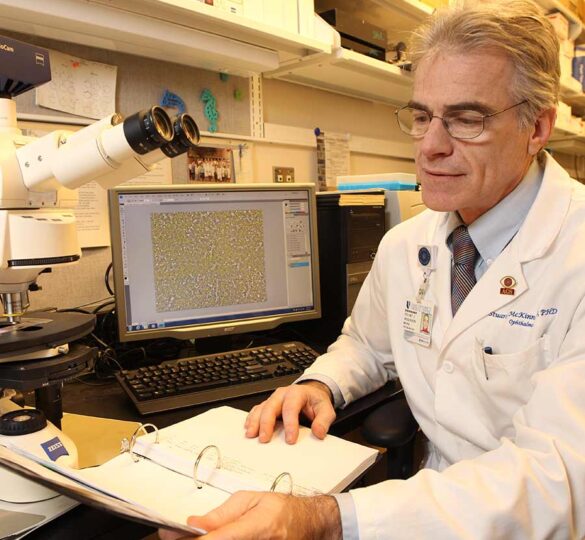Restoring Vision: Retinal Nerve Cell Regeneration
Researchers have made great progress in understanding the process of optic nerve degeneration and regeneration in glaucoma.

Glaucoma is a leading cause of blindness worldwide. Vision loss from glaucoma occurs when axons in the optic nerve become damaged and can no longer carry visual information to the brain.
Glaucoma is most often treated by lowering pressure in the eye with drugs, laser surgery, or traditional surgery. However, these treatments can only preserve remaining vision; they don’t improve or restore vision that already has been lost due to glaucoma.
Why is Vision Loss in Glaucoma Permanent?
The nervous system is divided into the peripheral and the central systems. Damaged peripheral nerves, in your arm for example, can regenerate after injury. However, the optic nerve and the spinal cord are in the central nervous system and unfortunately cannot regenerate after injury. This is why vision loss from glaucoma, like paralysis from spinal cord injury, is permanent. The unique cellular environment of nerve cells in the central nervous system may be why regeneration is prevented.
Regeneration Strategies
One strategy to encourage nerve fiber growth is to remove inhibitory factors in the cellular environment. Researchers hope to prevent expression of molecules that suppress axon growth using molecular biology techniques. For example, antibodies may be introduced to block the inhibition and allow nerve fibers to re-grow. Other strategies are in development as well:
- Nerve grafts have been tried. However, when optic nerves are damaged, they respond by forming scar tissue; nerve fibers have not successfully regenerated across the scarred areas.
- Nanotechnology has been used to create a protein nanofiber structure through which axons can regenerate.
- Cellular implants are engineered cells that can give physical support to neuronal fibers and provide regeneration-promoting chemicals to aid in axonal growth.
- Genetic manipulations might help to stimulate optic nerve regeneration, but there is much research yet to be done in this area.
- Promoters of nerve growth such as oncomodulin have shown some promise in optic nerve regeneration.
- Stem cell approaches have shown great promise for regeneration in models of glaucoma. Multipotent stem cells are retrieved from tissues such as bone marrow and fat, thus avoiding ethical concerns.
Future Approaches to Regeneration
Researchers have made great progress in understanding the process of optic nerve degeneration and regeneration in glaucoma. Molecular factors have been identified for nerve fiber growth in the central nervous system. New strategies to prevent scar formation and guide nerve fibers are being developed using nanotechnology, gene therapy, and stem cells. The next challenges are to optimize nerve regeneration and test whether it restores functionally meaningful levels of vision for glaucoma patients.
Article by Stuart J. McKinnon, MD, PhD.
First posted on September 15, 2015; Last reviewed on April 19, 2022.

Stuart J. McKinnon, MD, PhD
Dr. McKinnon is a glaucoma specialist and Associate Professor in the Departments of Ophthalmology and Neurobiology at Duke Eye Center in Durham, North Carolina. He received the 2016 Shaffer Prize for Innovative Glaucoma Research from Glaucoma Research Foundation for his study on “Neuroinflammation: The Role of Lymphocytes in Glaucoma.”